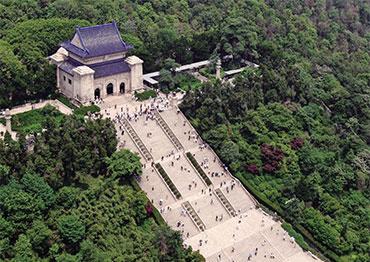f I had to use one word to sum up the Nanjing travel experience, it would have to be “legacy.” The Jiangsu provincial capital was once one of China’s most important cities, hosting the governments of both the Ming Dynasty (1368-1644) and the Republican government of the early 20th century. Though it has lost some of its stature in the decades since the national government left, the city, whose name means Southern Capital, has proudly preserved what remains.
While the city is replete with historical locations to visit, including a sprawling Mingera palace complex and a sobering memorial to the victims of the massacre carried out in the city by Japanese forces in 1937, there’s no better place to get a sense of the centuries of Nanjing’s history all at once than the leafy Purple Mountain scenic spot. The area, a short subway ride from the city center, is home to several sites that can take more than a day to fully explore, but if queues are light and you’re a quick walker you can probably fit the main ones into a single day.
Starting chronologically, the first stop is the Ming Xiaoling tomb complex. Built to house the remains of the dynasty’s founder, Emperor Hongwu, 100,000 workers started to build this UNESCO world heritage site in 1381 and finished 24 years later. A visitor is met at the entrance by a huge stone tortoise, one of the most famous of its kind, then follows a path to the magnificent “Ming Lou” main tomb that’s lined by statues of animals and warrior guardians. Atop the Ming Lou is a small exhibit explaining Emperor Hongwu’s rise to power and the influence of the tomb complex on later tomb architecture, but if you’re pushed for time it’s easily skippable.
Before you leave the area set aside for the tomb complex, I highly recommend a walk around a garden funded by charitable contributions from Japan. A visit in spring finds it awash in purple and pink blossoms of cherry and plum trees, along with several Japanesestyle pavilions and gates. During our visit on a national holiday, when every tourist spot was rammed full, it was still an oasis of calm.
A short stroll away is the former residence of Song Meiling, wife of Chiang Kai-Shek and member of the influential and powerful Song family. Set among maple trees, the large villa and its beautiful period furniture give a glimpse into the elegance with which we typically associate the Republican-era elite.
You can finish your day on Purple Mountain by visiting its most famous attraction, the mausoleum of Sun Yat-Sen, the man often called the father of modern China. While the monumental building and its setting are pretty awe-inspiring, even following the Ming tomb complex, I couldn’t help but feel that some of the solemnity one would associate with a mausoleum was lost on the path to its entrance, which is stuffed with fried chicken, potato-spiral-on-a-stick and milk tea stands. Still, it’s hard to say you’ve really visited Nanjing without a visit. And climbing the 392 steps gives a panoramic view of the area, and a virtuous feeling.
If an afternoon on Purple Mountain isn’t enough history for you, I’d also recommend a visit to the former Presidential Palace. Home to China’s government from the late 1920s – with a break due to Japanese invasion – it offers an intriguing mix of Western and Chinese architecture. The complex was previously the residence of various Qing officials, and was home to one of Chinese history’s most interesting characters, the self-proclaimed brother of Jesus Christ and leader of the Taiping Rebellion, Hong Xiuquan.
After the Presidential Palace, you could learn more about Hong and the bloody swath he cut through China by visiting the city’s Taiping Rebellion museum. But I’d recommend taking a break from history at the nearby Y2COFFE, a tiny café that will do you a delicious flat white or provide you with a bottled craft beer.
If you still want more hits of history, Nanjing Museum, one of the biggest in China, is full of relics – including a full jade burial suit, and a huge collection of Ming and Qing porcelain, housed in a 1930s building, with additions built in the 1990s.

 Old Version
Old Version

